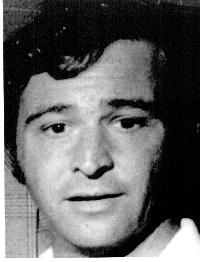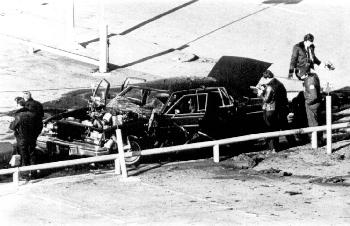Allan May, Crime Historian
Allan May is an organized crime historian, writer and lecturer. He also writes a monthly column for the Cleveland Plain Dealer. Contact him at AllanMay@AmericanMafia.com.
�Sammy G� Home Town Gangster
By Allan May
Salvatore Gingello was the most colorful gangland figure in Rochester,  New York�s organized crime history. His quick rise to fame and sensational ending was characteristic of the Rochester mob itself. New York�s organized crime history. His quick rise to fame and sensational ending was characteristic of the Rochester mob itself.
Born in Rochester in 1939, Gingello spent his entire life in the city. Called Sonny as a child, Gingello disliked the nickname and let people know it by being the toughest kid around in the Bay Street neighborhood where he grew up.
In the early 1960s, gang warfare began in Rochester. It would take almost three decades before it came to an end. The strife began shortly after the Appalachin Summit in November 1957. Constenze �Stanley� Valenti was the recognized boss of the city. Stanley was sentenced to 16 months in prison in August 1958. In his absence, Jake Russo began to take control of the Rochester rackets. When Stanley�s brother Frank, an ambitious capo in the Pittsburgh Crime Family tried to intercede, he found himself convicted on an election�s fraud charge and was sentenced to three years probation, but told to stay out of the state.
Frank bided his time and returned in September 1964 when his three years were up. In December, Russo disappeared and was never seen again. Hosting a party at a popular restaurant, Frank Valenti let it be known that he was the man to see in Rochester.
As Salvatore Gingello moved up the ranks during the mid-1960s, one Russo loyalist was still in the area, William �Billy� Lupo. In early 1970, Gingello became a capo. He got involved in a scam collecting deposits for a gambling junket to Las Vegas. Gingello and his associates kept the money, but called the police and reported it stolen. With a lot of angry gamblers in the area, Gingello and family underboss, Samuel J. �Red� Russotti, placed the blame on Lupo and used the incident as an excuse to have him murdered.
The increased underworld activity in Rochester drew the attention of the local police and government agencies. Valenti and his men responded with a public bombing campaign to keep the authorities distracted. On October 12, 1973 five bombs exploded around the city. They would be dubbed the �Columbus Day Bombings� by the media. The explosions obtained the results Valenti had hoped for and he continued with additional bombings through the balance of the year. A federal investigation into the bombings eventually turned up who was responsible for them and Valenti, Gingello, and Rene Piccarreto, the family consigliere, were indicted along with Gingello�s brother Anthony and four others. Eugene DeFrancesco, who constructed the bombs, was found guilty while everyone else was released.
In the early 1970s, Russotti, Gingello, and Piccarreto discovered that through a special crew Valenti had established, he was skimming thousands of dollars from activities and keeping the money for himself. After the three men brought their accusations to him, Valenti ordered them killed by Dominic Chirico, the capo of the special squad. By this time, Russotti, Gingello and Piccarreto had so many loyalists within the family that the order to kill them was ignored. Instead, it was Chirico who found himself on the wrong end of a shotgun in June 1972. With Valenti�s muscle removed, the Rochester mob was under new leadership.
Under this new regime, members of the former special crew were reassigned. When Gingello found that one of these members had violated rules by being with another family member�s girlfriend, he had the man beaten and expelled from the family. When another member of this special squad, Vincent �the Hammer� Massaro, began complaining about the new leadership, he was killed on November 23, 1973. His death would bring down Russotti, Gingello, and Piccarreto, as they were found guilty of conspiracy to murder and were sentenced from 25 years to life in January 1977. However, one year later, they were released after a Monroe County Deputy Sheriff revealed that evidence against the mobsters had been fabricated.
Out of circulation for only one year, the Russotti, Gingello, Piccarreto regime found themselves at war trying to regain their old rackets. Thomas Didio, who had been anointed acting boss, was not about to relinquish power and the battle for Rochester was underway. Called the �A & B War,� or the �Alphabet War,� by the newspapers, those loyal to the past leadership were referred to as the A Team, while Didio�s forces were called the B Team.
Russotti, upon leaving prison, had indicated to the newspapers that he was retiring from the rackets. Whether this is true or not, Gingello was being hailed as the new boss in some circles, and he was the man the B Team was targeting for assassination. B Team members felt that by killing the colorful Sammy G, �on the fence� operators, family members, and associates would be swayed to their side.
Between February and April 1978, five unsuccessful attempts were made to kill Gingello with a bomb. Gingello knew he was a target, but felt he needed to show himself to rally his own troops as the B Team members were deep in hiding. Surrounding himself with two overstuffed bodyguards, Thomas Torpey and Thomas Taylor, Gingello continued about his business, eating lunch at his favorite restaurant, the Blue Gardenia, and visiting popular city night spots.
During the planning sessions to kill Gingello, the suggestion came up to lower a bomb down his chimney. This plan was quickly discarded when a review of his home revealed that the house didn�t have a chimney. A second plan to plant the bomb in a child�s Big Wheel in front of the house was dismissed as being too risky to neighborhood children. On March 2, 1978, an attempt to kill Gingello outside the Blue Gardenia failed. The killer, hiding in the trunk of a car in the parking lot, triggered a bomb hidden in a snow bank near the restaurant�s entrance. The explosion sent Gingello air born, but he escaped any serious injury.
Still not deterred, Gingello continued his rounds making himself seen. At 1:15 a.m. on April 23, 1978, Gingello stopped at Ben�s Caf� Society on Stillman Street. Along with his two bodyguards and two young nephews, this had been their third club stop. Around 2:00 the nephews left, and twenty minutes later, Gingello and the two Thomas�s walked out. Gingello got into the driver�s seat of a borrowed black Buick and closed the door. The two bodyguards got in but before they closed their doors, a bomb placed under the car was detonated by remote control.
Because they had not had time to close their doors, the two  bodyguards were blown out of the automobile, the extent of their injuries being one broken foot. Gingello was not as fortunate. His right leg was blown off below the knee and his left leg was nearly severed at the thigh. His entire body was blackened from the powder of the explosion. He was rushed to Genesee Hospital where he died at 3:35 from shock and loss of blood. With him when he died were his father and other family members. bodyguards were blown out of the automobile, the extent of their injuries being one broken foot. Gingello was not as fortunate. His right leg was blown off below the knee and his left leg was nearly severed at the thigh. His entire body was blackened from the powder of the explosion. He was rushed to Genesee Hospital where he died at 3:35 from shock and loss of blood. With him when he died were his father and other family members.
A sordid crowd of drunks, hookers, and pimps, flocked to the scene of the battered black Buick. Women from a nearby massage parlor ran out into the cold night in their leotards to see what had happened. When police finally removed the car, twelve hours later, souvenir hunters and morbid curiosity seekers moved in to collect jagged pieces of metal and glass and even shards of flesh left behind in remembrance of Sammy G, their home town gangster.
Editors Note: A special thanks to Greg Q. and April T. for their research assistance with this article.
Copyright A. R. May 1999

|

